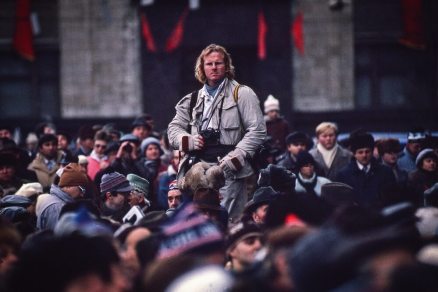“The one thing that is always clear in my mind is that the people, and their stories, and the themes of life that I photograph are always more important to me than the process of photography itself.” -Peter Turnley
Ukraine refugees
Peter Turnley has witnessed conflicts for the past forty years. Recently, he spent a week near the border Ukraine shares with Poland. For a week, he watched and photographed as Ukrainians fled from Russian invaders, bombings, shelling and missile strikes. His subjects are refugees who have been forced to leave their homes and often, their families (opening photo).
At this time, more than three million people, mostly children, the elderly and women have been forced to seek new places to live as refugees. They do not know if they will see their loved ones again. Men have stayed behind to fight for Ukraine. These pictures have emotional tolls on people who see them and on Turnley too.
He told CBS Sunday Morning correspondent Lee Cowan, “I ran into a journalist, and he asked me what I had experienced. And I told him the sense of guilt that I felt that I could walk away from the situation and the people that I had seen could not. And I literally, without warning, just began to sob.”
High school photographers

Peter Turnley has a twin brother, David, who is a photographer too. The two are among the finest photojournalists in the world. It started in high school in 1972 when the two boys with a single camera and lens between them began photographing a three-block street near downtown Ft. Wayne, IN. They called their project “McClellan Street.”
They had made a photo of an elderly man then submitted it to a National Scholastic Photography contest, and it won. In order to collect the prize, they had to find the man and have him sign a model release. They found him on a porch on McClellan Street. While talking with him, they noticed on every other porch had working-class white and Hispanic residents with children playing around them. The two boys decided right then to spend a year photographing the street life.
They made postcard-sized prints for their subjects who they soon realized always looked forward to seeing them again. By the end of their year families had albums of their photographs. Those photos helped them be part of the families they photographed. They could walk into any of their homes to continue their project.
David goes to New York
At the end of the year, David was the one to go to New York to show the project. Neither one had been on an airplane. David went to Magnum agency and asked the receptionist if he could show their work to someone. He was told that he would have to leave the portfolio and the agency would contact them later. David replied that if it was alright he would just wait to see if someone could spare him five minutes.
Lee Jones, Magnum’s director came up to David and said, “show me what you’ve got.” After looking at the McClellan Street pictures, Miller said, “I want to see you get a good start.” She picked up the phone and called some heavy hitters in photojournalism — Cornell Capa, John Szarkwwski and John Morris. When Morris saw the work, he called Jim Hughes at 35mm Photography magazine. The boys’ work got several pages in the publication. Nice boost for a pair of 17-year-olds.
Photojournalist
In the over 40 years since the McClellan Street Project, Peter has worked in more than 90 countries. He photographed the fall of the Berlin Wall in 1989, the 1991 Gulf War as well as conflicts in Bosnia, Somalia, Rwanda, Chechnya, Haiti, Indonesia, Afghanistan, Iraq and the Israeli-Palestine battles.
Domestically, he was at Ground Zero on Sept. 11, 2001 and in New Orleans for Hurricane Katrina.
Newsworthy notables
Over the years, he has photographed Pope John Paul II, Lady Diana, Presidents Obama, Clinton, Reagan and George H.W. Bush.
Paris
Peter Turnley went to Paris for the first time in 1975. He has a home there. Paris has shaped him as a photojournalist and as an artist.
“John Morris had told me that Cartier-Bresson’s prints were made at a lab called Picto. I went there in the spring of 1976 and was given a tour of the lab by a very kind gentleman named Georges Fèvre, the head of the black and white printing service there.
“I saw men and women in white gowns looking at and discussing the tones of gray in prints of Cartier-Bresson’s photographs lying on a table. I decided at that moment, that I wanted to be a part of that experience. I had never studied photography, not believing much in this approach to becoming a photographer, but decided this lab and its atmosphere was a place where I could learn something worthwhile. There I met Voja Mitrovic, a Serb from Bosnia who had immigrated to Paris in 1967 who was the principal printer for Henri Cartier-Bresson for 35 years. Voja, one of the greatest traditional black and white printers in the world, became a close friend and has printed my own photographs for the last 20 years.”
Sources: CBS News, NPPA, Peter Turnley.
More stories about inspirational photographers are in On Photography.
Tell your story with the second annual Visual Storytelling Conference!
Experience four days of interactive, online training sessions featuring a range of educational content with experienced photographers and content creators. This free event kicks off with a series of technical boot camps to build essential skills, followed by live, online sessions on photography, video, business and social media. Join live from March 10-13, 2022!
